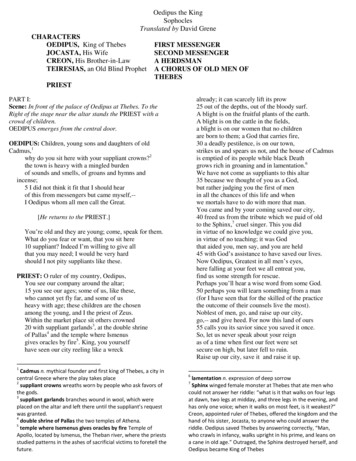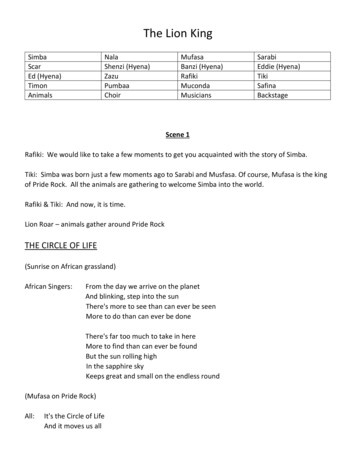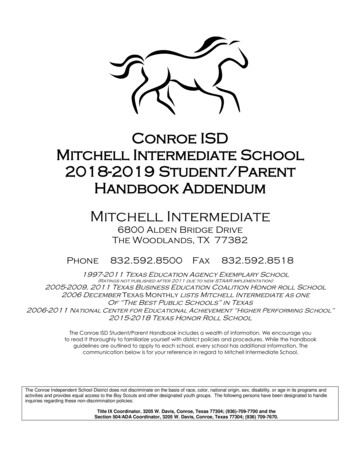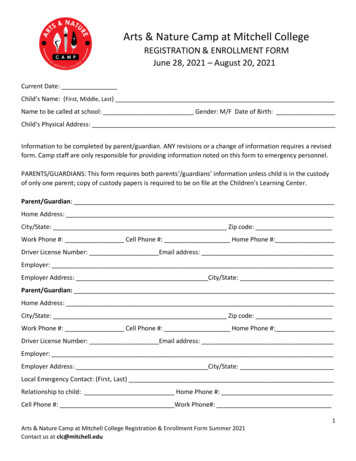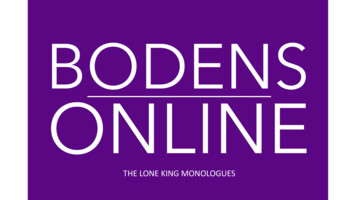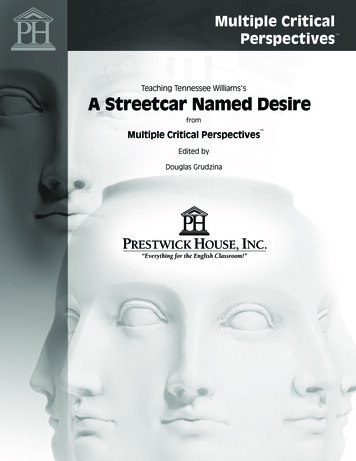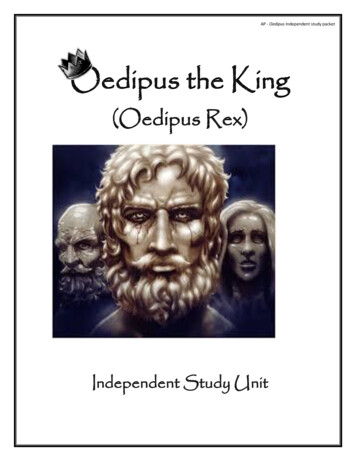
Transcription
AP - Oedipus Independent study packetOedipus the King(Oedipus Rex)Independent Study Unit
AP - Oedipus Independent study packetIt is to the ancient Greek culture, especially during the Golden Age of Greece, approximately fifth century, B.C., that we owe a greatdebt for the development of Western culture. Much of what we know Western culture to be today can find its origins in the culture of ancientGreece. This is particularly true in the development of drama. To this end, it is prudent to reflect upon the history of the Classic Age, and toappreciate its genius, for its legacy is omnipresent in our society.thThis unit is designed for 12 grade AP students and gives them an opportunity to focus on our Greek heritage of the drama, in general,and on the development of Greek tragedy, in particular. The intention of the unit is to illustrate the universality of Greek tragedy and itsextension into modern dramatic literature. Students will study in detail the paradigm of the Greek tragedy, Sophocles’ Oedipus the King, and willanalyze the influence of classical tragedy in other, more modern pieces.The Theban legend of Oedipus the King was well-known to Sophocles in fifth century B.C., as it was known to the people of Athens forwhom he wrote. Rather than merely retell an old story, what Sophocles did for the people of ancient Greece and subsequently for people ofWestern civilization, was to transform a tale of individual woe into an archetypal chronicle of human frailty, pride and punishment.Probably no Sophoclean tragedy better captures his tragic insight than Oedipus the King. A masterpiece of mystery, dramaticdevelopment, irony and characterization, the play begins barely one hour before the destruction of Oedipus, before he discovers the truth of hisidentity. Through relentless logic, the sins of Oedipus are uncovered, revealing the roots of his destiny and establishing him as the victim of hisown nobility. Oedipus is impressive in his active suffer, willing to accept full responsibility for what has occurred, willing to begin his exile andfuture destiny, as bleak as it appears to be, and caring more for others than himself. It is this nobility of spirit that Sophocles exalts, and it is thistragic spirit which calls audiences, century after century, to share the agony of Oedipus and to celebrate the ability of the individual “not only toendure, but to prevail.”To study Oedipus the King, considered by Aristotle to be the most perfect tragedy available in his time, is to touch our common heritageand to enrich our lives. A brief play in comparison to dramatic works of later centuries, Oedipus the King provides fecund opportunity to exploreirony, poetic devices, generic dramatic structure, the role of the chorus, archetypal criticism and the classical definition of tragedy, contained inthe Poetic by Aristotle.Objectives:By the end of this Unit, students will be able to:identify how Aristotle’s three unities are observed in the playidentify the role of dramatic irony in the playanalyze the theme of fate being more powerful than free willexamine the role of fate in Greek tragedydiscuss the importance of blindness and sight in the play, and identify how various characters either have vision or are blindexamine how Sophocles builds suspense in the playGain an insight into Greek tragedy and such concepts such as fate, hubris, and (dramatic) irony.Recognize the Greeks concern with fate, self-determination and the role of gods and oracles in everyday life.Learn about the origin and development of drama in Athens in the 6th and 5th centuries BC.Analyze and critically assess the specific role of characters within the play and role of the chorus.Essential Questions:Are we creatures of fate or of free will?What makes a good leader?Are we capable of seeing our own lives objectively?Is our fate as human beings predetermined by a greater forcer than ourselves? Do we have control over our destiny?What can we learn about ourselves as citizens, artists and human beings by studying and performing the classics?What influence has Ancient Greece had on our lives today?Unit QuestionsWhy is Oedipus Rex still relevant today?How is Oedipus Rex a classic example of Greek Drama?What makes Oedipus Rex different to a contemporary play?How does Oedipus’s role as a King affect our empathy as an audience?How is today’s audience different to Ancient Greece?How are the beliefs of Ancient Greece reflected in the text?How would you cast the role of the chorus today?Tragedy (main concept), tragic hero, foil, motif, diction, ironyTragedy generates suspense not in the events of the story (plot) but in the reaction of the characters.Tragedy survives as an art form because it allows us to learn from the mistakes of others.The Aristotlean definition of tragedy provides a structural template which later authors borrow from and allude to.
AP - Oedipus Independent study packetPLEASE COMPLETE THE ASSIGNMENTS IN THE ORDER LISTED. WORKSHEETSARE SPECIFIC TO CERTAIN SCENES / ODES.NUMBERED H/O #7- #25 ARE IN ANOTHER FILE.Assignments1View and take notes on Greek Theater PPT / be sure to copy lit. terms on lit term sheet2Read and take notes on Sophocles bio3Read H/O #7 “The Legend of Oedipus” (highlight)4Review “gods” info chart5Complete ANTICIPATION GUIDE.6Review Oedipus Terms Sheet78YOU WILL NEED TO SUMMARIZE EACH SCENE AND EACH ODE IN YOUR READING LOGRead PROLOGUE / PROLOGOS9Complete H/O #810Complete H/O #9 – Charting clues & complete Prologos boxesPoints151052024completed1112Complete H/O #10 (The parados)Copy on the back of handout #10 –The Parados (look very closely at thelanguage/diction):What does Ares represent to the Chorus? What various things do they wish forhim?How does the mood of Strophe 2 and Antistrophe 2 contrast with the mood of thefirst strophe and antistrophe? What images in the second pair of stanzas focus ondeath and decay?10413Read Scene 1 / Summarize514Complete H/O #11 Oedipus Meets Teiresias2815Literary Term: Paradox- A statement that seems contradictory but actually reveals a truth.16Complete scene 1 AP questions2217Complete H/O #12 – “Teiresias and the Paradox of Blindness” still for scene 11018Fill in Scene 1 box on “Charting the Clues” handout #919Read Ode / Stasimon 1, SUMMARIZE, and answer the Ode / Stasimon 1 questions5 pnts6 pntsCopy on Literary Terms sheet:1. RHETORIC – the effective use of language2. STICHOMYTHIA (line talk) – (stik uh MITH e uh) - a form of dramatic dialogue inwhich two disputing characters answer each other rapidly in alternating singlelines, with one character's replies balancing (and often partially repeating) theother's utterances. This kind of verbal duel or ‘cut and thrust’ dialogue waspracticed more in ancient Greek and Roman tragedy. It occurs frequently in Greekdrama, especially when characters are arguing or expressing strong emotions.2011Done
AP - Oedipus Independent study packetAssignmentsPoints21Read Scene 2 CREON, THE CHORAGOS, OEDIPUS & JOCASTA– and see if you can identifyexamples of stichomythia22SUMMARIZE SCENE 2523Complete H/O # 14 on stichomythia424Fill in Scenes 1 & 2 on H/O #9 if not already done.25Complete H/O #13 – Oedipus accuses Creon (for Ode 1 & Scene 2)26Read Ode 2. Introduce the function of the Greek Chorus- (Roles – Strophe 1, Antistrophe 1,Strophe 2 & Antistrophe 2)27Read H/O # 152424completed28complete boxes for the Parados, & Odes 1 & 2 (H/O # 15)29Read Scene 3 and Ode 3 (ROLES: SCENE 3-JOCASTA, MESSENGER, LEADER (CHORAGOS), OEDIPUS;ODE 3 - CHORUS (STROPHE & ANTISTROPHE)30SUMMARIZE & Fill in Scene 3 on H/O #9 and fill in Ode 3 on H/O # 155 pntsComplete H/O #16 – The Messenger from Corinth (Scene 3) – may need internet313233546Copy Lit. Term: Apostrophe- the act of addressing some abstraction or personification that is notphysically present: For instance, John Donne commands, "Oh, Death, be not proud." King Learproclaims, "Ingratitude! thou marble-hearted fiend, / More hideous when thou show'st thee in achild / Than the sea-monster." Death, of course, is a phenomenon rather than a proud person, andingratitude is an abstraction that hardly cares about Lear's opinion, but the act of addressing theabstract has its own rhetorical power. An apostrophe is an example of a rhetorical trope (arhetorical device or figure of speech involving shifts in the meaning of words).Introduce Mt. Kithairon as a central image in the playExplain the significance of Mt. Kithairon – rising above the city of Thebes, it was supposed to be the location where peoplewent to pray to / worship Dionysus. It was the home of all foundlings – those lost in the wilderness (like Oedipus) / a placeof protection. Ultimately, O. will cry out against it, in the end, for protecting him in his infancy. Symbolically, the mountainrepresents the struggle of man’s quest (the difficult mountain to climb) for perfection (the perfect blend of mind and spirit)which would make him like a god. As a man achieved greatness in his quest (overcoming some of the obstacles along thatclimb) he usually got a little cocky and displayed hubris, which would inevitably lead to his fall. This is what the Choruswarns O. of in Ode 2. Though he climbed the heights of intellect and greatness (solving the riddle and becoming king), hemust be cautious of hubris. As a result, there is glory in the climb, and ignominy (disgrace) in the fall.3435363738In this sense, Sophocles uses the mountain for a dramatic purposeComplete H/O #17. DO NOT DO LETTER “F” IN PART IIICreate a chart for II & IIIread Scene 4 & Ode 4Summarize & update H/O #9 & #155 pnts.Complete H/O #18 – The Final Clue for Scene 4 & Ode 4Complete H/O #19 Understanding Irony (for SCENE 4 & ODE 4)Explain that irony is an important element of Greek tragedy in that it intensifies the dramaand increases the suspense – we can’t wait to see how the character will react when he findsout what we already know4051618Done
AP - Oedipus Independent study packetAssignmentsPoints39Read the Exodus (ROLES: SECOND MESSENGER, CHORAGOS, OEDIPUS, & CREON)40Summarize Exodus, complete H/O #9 & H/O #15541Complete H/O #20 – Unraveling the mystery3242Lit Term - ARCHETYPE: the original pattern or model from which all things of the same kind arecopied or on which they are based; a model or first form; prototype. (in Jungian psychology) acollectively inherited unconscious idea, pattern of thought, image, etc., universally present inindividual psyches.43Complete Oedipus as archetype handout #23 (page 1 – 3)44Read H/O #24 – Classic definition of tragedy AND45Copy lit. terms:Classical unities or three unities - are rules for drama derived from a passage inAristotle's Poetics. In their neoclassical form they are as follows:1.The unity of action: a play should have one main action that it follows, with noor few subplots.2.The unity of place: a play should cover a single physical space and should notattempt to compress geography, nor should the stage represent more thanone place.3.The unity of time: the action in a play should take place over no more than 24hours.Peripeteia - a sudden or unexpected reversal of circumstances or situation especially ina literary work20Anagnorisis - the point in the plot especially of a tragedy at which the protagonistrecognizes his or her or some other character's true identity or discovers the true natureof his or her own situationA complex plot - in contrast to a simple plot, includes a reversal of the dramatic situation(peripeteia) and/or recognition (anagnorisis). Complex plots unfold through an internallogic and causality; they are not simply strings of episodes.46complete H/O #251547Complete Unities of Action PLOT chart – be sure to label the peripetia, the anagnorisis & thecatastrophe12TOTAL PACKET (IN RL) WORTH435Done
AP - Oedipus Independent study packetANTICIPATION GUIDEFOR Oedipus the KingAgree or Disagree? Read the following statements. Write an “A” if youagree, or a “D” if you disagree on the line next to the statement. When youhave completed the assignment, you will have a chance to explain youranswers.Remember, there are no right answers, but you will have to defend yourthoughts and opinions.1.It is possible to escape or trick fate.2.If we truly know ourselves, nothing bad will ever happen to us.3.We should not attempt to justify our actions, good or bad.4.Family secrets are best kept as just that – secrets.5.If you are in charge, you are allowed to be exempt from consequences.6.We should engage ourselves in bettering our community, even if it is ourselves that wemust change.7.Society places the burden of the sins of the parents on the heads of the children.8.There is more than one way to see.9.It is better to place blame on those around us than to look inside ourselves.10.There are no coincidences.11.All types of pride are evil.
AP - Oedipus Independent study packetGods Possibly Mentioned in OedipusGreek-to-Roman Mythology Name Conversion ChartGreek NameRoman NameIdentitySymbolsAphroditeVenusGoddess of love and beauty; Goddess ofpleasure; Goddess of Laughter and Fertility;Daughter of Zeus; Mother of Eros; Wife toHephaestusMyrtle, Dove, Sparrow, Swan,Sceptre, Swallow, Hearts, Red Roses,CupidsAresMarsGod of War;Parents: Zeus & Hera (theirmost hated child); Aphrodite is his mistressSpear, Dog, Sword, HelmetArtemisDianaGoddess of the Moon; Goddess of Virginity andChildbirth; Protector of Youth and Children;Twin sister Phoebus; Parents: Zeus and LetoBear, Bow, Deer, Forest, Moon,Cyprus TreeAthenaMinervaGoddess of Wisdom; Brain child of Zeus; MostIntelligent; Patron God of Cities and CivilizedLife; God of handy craft Parents:Zeus and MetisAgriculture, Wisdom, War, Purity,Aegis, Owl, Olive Tree, Athens,Golden Bridal, Flute, Weaving Loom,Helmets, Staff, Shield, Spider Webs,Head of MedusaCronusSaturnGod of time; Ruler of the Titans; God ofagriculture; Wife is Rhea; Father to many Gods;Parents: Ouranus and GaeaCrow, Candle, Harvest, Sicle, Stone,Sun, Moon, Stars, PlanetsDionysusBacchusGod of wine; Patron god of animal life andvegetation life; God of Intoxication; Believes infreedom and civilazation; God of drama andFertility; Earth godGrape Vine, Ivy, Thyrsos, GoldenChallis, Dolphin, Torch, Grapes,Purple Cloak, Serpent, Ram, Tiger,Panther, Lynx, LeppardErosCupidGod of love; Son of Aphrodite and Ares;Gangster of love; God of the weddingBow and Arrow, Blindfold, MagicBow, Silver, Lead, and Gold Arrows,Pierced HeartGratiaeGoddesses of happiness,beauty & feast; NamesAglia (splendor), Euphrosyne (mirth), Thalia(Good Cheer); Queens of song, banquets, andsocial lifeFull Banquet Table, Songs, MyrtleTree, Grace, Beauty, Dance, Purity,Flowers, Young Maidens, Gentleness,Decorum, GratitudeThe ThreeGraces
AP - Oedipus Independent study packetThe GraieHadesHermesMedusaThe MusesThe GraeaePlutoGray-haired since birth, have only one eye andone tooth that they share; They lived on theouter layer of the ocean; Known for wisdom;Feast on flesh and Human Brains which theycook; Their names are Enyo, Dino, and PephredoEye, Tooth, Boiling Couldren, LongGray HairSceptre, Cerberus, a cap of invisibility,the key to the underworld, allGod of the mineral wealth of the earth; Zeus'precious metals and gems; threebrother; Third in Power; Ruler of the dead; Wifeheaded dog, a two pronged staff,Persephone;black cyprus, black chariot, horses.Four seasons, ram, dolphinMercuryThe messenger God; Delivered Pandora topunish man; master thief; God of commerce;Protects travelers; God of athletes and speech;Brings souls to the underworld; Patron ofDoctorsWinged Helmet and Sandals,Caduceus, Lyre, Magic Wand,Doctors Staff, Tortoise, Palm Tree,DogNONEBorn Human; Made into a gorgon by Athena;Cries blood tears, has brass claws and BrassWings, has Serpent Hair; Killed by Perseus; Aftershe died Pegasus arose from her bleeding trunk;Can Turn a man to stone with one glance;Parents: Phorcys & CetoStatues of man, serpents, Pegasus,Bow and ArrowCamenaeInspiring goddesses of songs; Clio - History,Urania - Astronomy, Melpomene - Tragedy,Disciplines of Literature, Art andThalia - Comedy, Terpsichere - Dance, Calliope Science, Stairway, Flute, Drama MaskEpic Poetry, Erato - love poetry, Polyhymnia Songs to the gods, Euterpe - Lyric PoetryPanFaunusGod of shepherds & flocks; Satyr, he has Goathands, legs, and hoofs and human arms and head;Father Hermes; God of woods and fields; Patrongod of the shepherds; Patron and Protector of allforest animals; Invented the Shepherd PipesPhoebusApolloGod of Music; Son of Zeus; Twin Brother ofBow, Lyre, Laurel Tree, Dolphin,Artemis; God of Truth, Archery, Philosophy, and Crow, Silver Bow, Lighted Torch, SunLight; Great Healer; God of ProphecyGolden ChariotPoseidonNeptuneGod of earthquakes & the sea; Brother of Zeus;Second in Power; Ruler of Sea; God of FertilityAnimals, Red PineTrident, Horse, Bull, Dolphin, SeaHorses, Waves, Earthquakes
AP - Oedipus Independent study packetZeusJupitorGod of the heavens, weather, fate, & kings; RainGod; Cloud Gatherer; Thunder Maker; Lord ofthe Universe; Son of Cronus and Rhea; ManyBrothers and Sisters Parents: Cronus and RheaThunderbolt, Eagle, Oak Tree, Aegis,Eagle, Golen Mist, Bull, Swan, Dear
AP - Oedipus Independent study packetGreek Dramatic Structure – Divided into 5 distinct sections1.2.3.4.5.Prologue (Prologos) – The opening portion of the play. It sets the scene and contains theexpositionParodos – The entrance song of the chorus. They are named after the broad aisles on eachside of the theatre, along which the chorus entered or exited.Episodes (scenes) – The scenes in the action of the drama. The episodes, performed by theactors, are distinguished from the stasimons, performed by the chorus. The episodesalternate with the stasimons.Stasimons (odes) – choral passages, alternating with the episodes of the plot of the drama.The ode is a type of lyric poem, using exalted, dignified diction, a poetic form created for thechoral passages. The chorus sang and danced the tragic odes, accompanied by musicalinstruments. The tragic ode consisted of strophes and antistrophes, essentially stanzas ofthe poems. The chorus sang the strophe, dancing in one direction around the orchestra,changing directions with the antistrophe.Exodus – The concluding section of the tragedy. Ends with the chorus singing their finallines as they exit.OTHER LITERARY TERMS6.Lyric poem-song-like poetry that focuses on expressing emotions and thoughtsChoral songs were divided into stanzas: strophe (turn), antistrophe (turn the other way), andepode (added song) that were sung while the chorus moved (danced). While singing the strophean ancient commentator tells us they moved from right to left; while singing the antistrophe theymoved from left to right.7.8.9.Strophe – the first of the three series of lines forming the divisions of each section of aPindaric ode (An ode in the form used by Pindar [Ancient Greek lyric poet fromThebes], consisting of a series of triads in which the strophe and antistrophe have thesame stanza form and the epode has a different form). The part of an ancient Greekchoral ode sung by the chorus when moving from right to left.Antistrophe-the part of an ancient Greek choral ode answering a previous strophe,sung by the chorus when returning from left to right.Epode - the part of a lyric ode following the strophe and antistrophe and composingwith them a triadic unit.
AP - Oedipus Independent study packetOedipus the King – AP QuestionsSCENE / EPISODE 1 (Limited Teiresias questions) complete before H/O #121.Reread Oedipus’ long speech beginning, “Ye *-*-*pray; ‘tis well, but would ye hear my words.” Whatis his tone?2. Why does Oedipus insist that he will seek out and avenge Laius’ murderer?3.In this speech, Oedipus refers to Laius’ descendants as “ill-fated,” but to his own good fortune inobtaining Laius’ throne as driven by “chance.” Explain the difference between these two concepts, andwhy Oedipus might choose to characterize these events in different ways.4.Structurally, why is it appropriate for the Chorus / Choragos to appear now?5.Once again, in whose voice does the Chorus speak?6.Why is it significant that it was Creon whom Oedipus sent to the Oracle and now it is Creon whomOedipus has sent to get Tiresias?7.Explain what Tiresias means by his first statement to Oedipus. “How terrible to know when it does nothelp the knower” OR other translation: “How dreadful knowledge of the truth can be / When there’sno help in truth!”8.How does the Chorus serve as the “conscience” of the play?9.How is Tiresias’ response to being ordered to leave comic and ironic? What traits of Oedipus’ does thisemphasize?10. What does Tiresias mean when he predicts, “This very day will sire you and destroy you” OR othertranslation: “This day will give you a father, and break your heart”?11. Why does Tiresias say that Oedipus, of all people, should understand his riddles?
AP - Oedipus Independent study packetOedipus the KingOde / Stasimon 1 Questions1. According to Ode 1, which god will inevitably punish the murderer of Laius? Whatmisgiving disturbs the Chorus’s confidence in this ode, and how do they deal with thismisgiving?2. In the course of Ode 1, the Chorus expresses both confident optimism and nervousapprehension. How is the Chorus’s indecision a comment on the basic conflict of theplay so far? What possible resolutions to the conflict can you predict?3. What seems to be the function of this ode in response to the preceding scene (scene 1)?
AP - Oedipus Independent study packet
AP - Oedipus Independent study packetBalance presented in Greek architecture and art
AP - Oedipus Independent study packet
AP - Oedipus Independent study packetArchetypesCarl Jung first applied the term archetype to literature. He recognized that there were universal patterns in all stories andmythologies regardless of culture or historical period and hypothesized that part of the human mind contained a collectiveunconscious shared by all members of the human species, a sort of universal, primal memory. Joseph Campbell took Jung’sideas and applied them to world mythologies. In A Hero with a Thousand Faces, among other works, he refined the conceptof hero and the hero’s journey—George Lucas used Campbell’s writings to formulate the Star Wars saga. Recognizingarchetypal patterns in literature brings patterns we all unconsciously respond to in similar ways to a conscious level.The term archetype can be applied to: An imageA themeA symbol An ideaA character typeA plot pattern ReligionsFantasiesFolkloreArchetypes can be expressed in MythsDreamsLiteratureHeroic Archetypes:1.2.3.4.Hero as warrior (Odysseus): A near god-like hero faces physical challenges and external enemiesHero as lover (Prince Charming): A pure love motivate hero to complete his questHero as Scapegoat (Jesus): Hero suffers for the sake of othersTranscendent Hero: The hero of tragedy whose fatal flaw brings about his downfall, but not without achievingsome kind of transforming realization or wisdom (Greek and Shakespearean tragedies - Hamlet, Macbeth, etc.)5. Romantic/Gothic Hero: Hero/lover with a decidedly dark side (Mr. Rochester in Jane Eyre)6. Proto-Feminist Hero: Female heroes (The Awakening by Kate Chopin)7. Apocalyptic Hero: Hero who faces the possible destruction of society8. Anti-Hero: A non-hero, given the vocation of failure, frequently humorous (Homer Simpson)9. Defiant Anti-hero: Opposer of society’s definition of heroism/goodness. (Heart of Darkness)10. Unbalanced Hero: The Protagonist who has (or must pretend to have) mental or emotional deficiencies (Hamlet,One Flew Over the Cuckoo’s Nest)11. The Other—the Denied Hero: The protagonist whose status or essential otherness makes heroism possible(Invisible Man by Ralph Ellison, The Joy Luck Club by Amy Tan)12. The Superheroic: Exaggerates the normal proportions of humanity; frequently has divine or supernatural origins. Insome sense, the superhero is one apart, someone who does not quite belong, but who is nonetheless needed bysociety. (Mythological heroes, Superman)Types of Archetypal Journeys1.2.3.4.5.The quest for identityThe epic journey to find the promised land/tofound the good cityThe quest for vengeanceThe warrior’s journey to save his peopleThe search for love (to rescue theprincess/damsel in distress)6.7.8.9.10.The journey in search of knowledgeThe tragic quest: penance or self-denialThe fool’s errandThe quest to rid the land of dangerThe grail quest (the quest for human perfection)
AP - Oedipus Independent study packetStages of a Hero’s JourneyStage 1:Stage 2:Stage 3:Stage 4:Stage 5:Departure: The hero is called to adventure, although he is reluctant to accept.Initiation: The hero crosses a threshold into a new, more dangerous world, gaining a more mature perspective.The Road of Trials: The hero is given supernatural aid, endures tests of strength, resourcefulness, andendurance.The Innermost Cave: The hero descends into the innermost cave, an underworld, or some other place of greattrial. Sometimes this place can be within the hero’s own mind. Because of this trial, the hero is reborn in someway—physically, emotionally, or spiritually. Through this experience, the hero changes internally.Return and Reintegration with Society: The hero uses his new wisdom to restore fertility and order to the landCharacteristics of the Hero’s JourneyThe hero is naïve and inexperiencedThe hero meets monsters or monstrous menThe hero has a strange, wise being as a mentorThe hero years for the beautiful lady who is sometimes his guide or inspirationThe hero must go on a journey, learn a lesson, change in some way, and return homeThe hero often crosses a body of water or travels on a bridge.The hero is born and raised in a rural setting away from citiesThe origin of the hero is mysterious or the hero losses his/her parents at a young age, being raised by animals or a wiseguardianThe hero returns to the land of his/her birth in disguise or as an unknownThe hero is special, one of a kind. He/she might represent a whole nation or cultureThe hero struggles for something valuable and importantThe hero has help from divine or supernatural forcesThe hero has a guide or guidesThe hero goes through a rite of passage or initiation, an event that marks a change from an immature to a moremature understanding of the worldThe hero undergoes some type of ritual or ceremony after his/her initiationThe hero has a loyal band of companionsThe hero makes a stirring speech to his/her companionsThe hero engages in tests or contests of strength (physical and/or mental) and shows pride in his/her excellenceThe hero suffers an unhealable wound, sometimes an emotional or spiritual wound from which the hero nevercompletely recovers.
AP - Oedipus Independent study packetSituational ArchetypesArchetypeDescriptionThe QuestWhat the Hero must accomplish in order to bring fertility back to the wasteland,usually a search for some talisman, which will restore peace, order, and normalcyto a troubled land.The TaskThe nearly superhuman feat(s) the Hero must perform in order to accomplish hisquest.The JourneyThe journey sends the Hero in search of some truth that will help save hiskingdom.The InitiationThe adolescent comes into his maturity with new awareness and problems.The RitualThe actual ceremonies the Initiate experiences that will mark his rite of passageinto another state. A clear sign of the character's role in his societyThe FallThe descent from a higher to a lower state of being usually as a punishment fortransgression. It also involves the loss of innocence.Death and RebirthThe most common of all situational archetypes, this motif grows out of a parallelbetween the cycle of nature and the cycle of life. Thus morning and springtimerepresent birth, youth, or rebirth, while evening and winter suggest old age ordeath.Battle betweenGood and EvilObviously, a battle between two primal forces. Mankind shows eternal optimism inthe continual portrayal of good triumphing over evil despite great odds.The UnhealableWoundEither a physical or psychological wound that cannot be fully healed. The woundsymbolizes a loss of innocence.
Character ArchetypesAP - Oedipus Independent study packetArchetypeDescriptionThe HeroThe Hero is a protagonist whose life is a series of well-marked adventures. Thecircumstances of his birth are unusual, and he is raised by a guardian. He willhave to leave his kingdom, only to return to it upon reaching manhood.Characterized by courage, strength, and honor, the hero will endure hardship,even risk his life for the good of all. Leaves the familiar to enter an unfamiliarand challenging world.Young Man from theProvincesThe Hero returns to his home and heritage where he is a stranger who can seenew problems and new solutionsThe InitiatesThe Initiates are young heroes or heroines who must go through some trainingand ceremony before undertaking their quest.MentorThe Mentor is an older, wiser teacher to the initiates. He often serves as afather or mother figure. He gives the hero gifts (weapons, food, magic,information), serves as a role model or as hero’s conscience.Mentor - PupilRelationshipIn this relationship, the Mentor teaches the Hero/pupil the necessary skills forsurviving the quest.The ThresholdGuardianTests the hero’s courage and worthiness to begin the journeyFather - SonConflictIn this relationship, the tension is built due to separation from childhood orsome other source when the two meet as men.Hunting Group ofCompanionsThese are loyal companions willing to face hardship and ordeal in order to staytogether.Loyal RetainersThe Retainer's duty is to reflect the nobility and power of the hero.Friendly BeastAn animal companion showing that nature is on the side of the heroThe ShadowA worthy opponent with whom the hero must struggle in a fight to the end.Must be destroyed or neutralized. Psychologically can represent the darker sideof the hero’s own psyche.The Dev
must be cautious of hubris. As a result, there is glory in the climb, and ignominy (disgrace) in the fall. In this sense, Sophocles uses the mountain for a dramatic purpose 34 Complete H/O #17. DO NOT DO LETTER “F” IN PART III Create a chart for II & III 40 35 read Scene 4 & O
